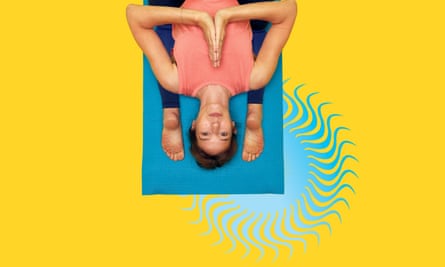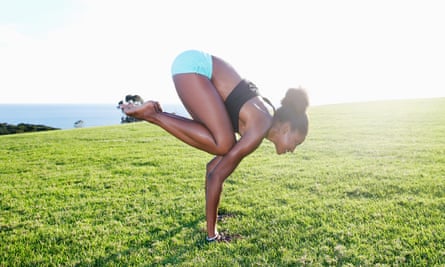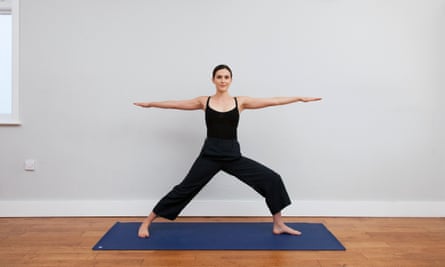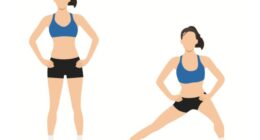Yoga is like faith, or grief, or dog ownership: from the inside, it is incredibly obvious and you would no more question it than you would breathing in and out (although, to be fair, with yoga there is a lot of chat about breathing in and out). From the outside, it is baffling: it looks incredibly slow and boring, unless it looks extremely fast and challenging, and how can those two styles even share the same name?
Some poses, it is hard to believe the human body capable of, while others look more like napping. Can it possibly have the physical, psychological and spiritual impact its practitioners claim? And, if so, which form of it is best for you? Here’s what some old hands say, and what I’ve learned from my own adventures in yoga.
What if you don’t believe in the spirit? Are you still allowed to do yoga, and will you be doing it properly?
Meta-studies are pretty clear on the physical benefits: if you do yoga regularly, you will see improvements to balance, flexibility, strength, cardiovascular health and muscle tone.
However, to describe it in purely physical terms is to miss its philosophy. It is, says Amy Ku Redler, a yoga teacher of 30 years, “about connecting our physical, psychological, emotional and energetic beings – connecting ourselves to ourselves”. A yoga person wouldn’t try to sort the benefits into mind and body. They would take it as obvious that if yoga reduces anxiety, it will help a whole suite of inflammatory disorders caused by (and, in turn, exacerbating) stress: arthritis, poor digestion, broken sleep. It may be quicker to just say: it improves everything.
I asked my friend, 53-year-old Kirsten Lyle, on her way out of a vinyasa flow class in Ramsgate, Kent, why she had been doing it more or less her whole adult life. “The culture of it was never appealing to me,” she said. “When I was young, I’d listen to the introductory breathing section and think: ‘Yeah, get on with it. Get to the exercise.’
“But it starts to make sense. I don’t want to use corny words like holistic, but you realise the breathing is really helping you make the shapes in your body, and get the space in your mind. You have to go whatever mood you’re in. That’s the point – you have to show up.”

What’s this obsession with breathing?
It’s a core element of yoga, known as pranayama. Matching your breathing to the rhythm of your yoga posture can enable you to either hold or go deeper into a pose, for which you might otherwise be too restless or rigid. It cuts both ways: you could see the pose itself as a way to get deeper into the breathing, which is what will bring the clarity of mind that the whole thing’s supposed to be about.
Is there a plausible explanation for all this?
Scientists are increasingly interested in “interoception”, AKA the eighth sense. This means “listening in to the signals that your body gives you and responding accordingly”, in the words of Nahid de Belgeonne, author of the forthcoming Soothe: The Book Your Nervous System Has Been Longing For. Maybe your neck is tight or you’re shallow breathing; you have standard aches and pains; or a creeping sense of unease that’s making your heart race. These are things we spend our lives trying not to listen to but – newsflash! – that doesn’t make them go away.
Peter Blackaby, author of Intelligent Yoga, which is considered the bible of yoga and anatomy, writes about the fallacy of trying to understand the body mechanically, each muscle sorted into a neat, bookended entity and held responsible for a particular movement. It’s derived from the study of cadavers, and bears little resemblance to a living human body. As Ku Redler explains: “You have fascia, you have ligaments, you have feelings, you have emotions, you have thoughts, you have joints – there is a cognitive and emotional element to the way your body feels, even if you’re not interested in it.”
If we accept that the body is not a machine, and that mind and body are never separate, it starts to make sense that you may feel distress in your muscles, not your mind. As Blackaby writes: “Patterns of distress are always expressed through tightening and holding.”
Part of being able to hear your body’s signals will come from slowing down and focusing on your breath, which tricks you into a meditation of sorts. And part will come from movement, “paying attention to the quality of the movement, not the outcome,” De Belgeonne says.

Can you still do yoga if you don’t want to meditate?
“I’d say you could do, but you could be missing a connection with your inner world,” Ku Redler says. “Nobody’s walking around without feelings. Even if you don’t believe in meditation, you can’t deny the fact that you have thoughts and feelings and a physical body, and that those things are connected.”
The synchronous breathing element, however, is non-negotiable. “It’s a really good bridge between mind and body. If you’re not breathing, you’re not doing yoga,” De Belgeonne explains. “You’re just throwing shapes. You might as well join a circus class.”
Turning back to the science, the meta-study Exploring the Therapeutic Benefits of Pranayama (Yogic Breathing): A Systematic Review found that yogic breathing helped with respiratory disorders, including chronic obstructive pulmonary disease (COPD). If you have any experience of COPD in your family, you’ll know how surprising this is, because nothing works.
How do you know where to start?
Whatever anyone says later about yoga classes and their pitfalls – and they’re going to say a lot – they are a good gateway if you’ve never tried it before. The first class you try will probably lodge itself in your brain as the One True Yoga, whatever you settle on subsequently. So think about what you need, where you are in your life, and what the original purpose of each style was.
What is ashtanga?
This was huge in the 90s, a power yoga style that Madonna credited with getting back in shape after she had her daughter, Lourdes Leon, in 1996 (which was ridiculous as she was never not in shape – she looked like a python who’d swallowed a football – but never mind). It was originally devised, De Belgeonne says, “for young boys, to help them use up their sexual energy in a culture where they’re not allowed to touch girls”. You keep each pose for only five breaths, and it’s meant to be extremely physical – part of the point is that sweating profusely is cleansing. It’s good for cardio, muscle tone and weight loss.
What are restorative yoga and yin yoga?
If you’re not a celibate young boy, restorative or yin yoga may suit you better, being much slower, with poses held for up to 20 minutes and an emphasis on contemplation. Both styles focus on healing and stillness, so they’re good if you’re recovering from an injury, surgery, a broken heart, etc.

What is hatha?
This isn’t a fast-moving flow style either: it concentrates on the fundamentals of yoga with slower, sustained poses. People call it gentle, because it doesn’t look like a workout. “But sometimes if you’re in a hatha pose, it’s unbearable,” Lyle says. “You think: I cannot stay in this pose for one more second. So that’s when you have to breathe, and that’s when you realise the breathing works.”
It’s that stillness that I always found so off-putting, from a distance. When teaching people who are neurodiverse, De Belgeonne noticed: “They can’t sit and be still – it torments them.” But, she adds: “I don’t think many people can. Probably for every 30 minutes of meditation, you’ve got five minutes when you’re really still.”
What’s vinyasa flow?
This is quite fast, and very popular in the yoga-industrial complex because it’s recognisable from other gym classes, such as Zumba, with extra woohoo. That doesn’t mean it’s without merit, but going in as a novice to a big class, “you’re looking to copy and perform the best version of the position you’re taking”, De Belgeonne says. “So you’re not listening to the signals in your body.”
People love it for its intensity and dynamism: you could never get bored in a vinyasa flow class, though arguably boredom is the nursery slope of enlightenment.
READ RELATED: 27 Prime Day Wellness Deals to Shop Ahead of Big Deal Days
What is Iyengar?
Tirumalai Krishnamacharya was the original modern yogi, and from his practice came two branches – ashtanga (devised by Pattabhi Jois) and Iyengar (named after its founder, BKS Iyengar). It’s a very subtle form, focussing on alignment, and comes with props such as belts, blocks and bolsters to help you. It is amazing for posture: you almost feel your inner tectonic plates have shifted into a better place afterwards.

What is Bikram?
This was devised by Bikram Choudhury in the 70s in the US, and follows a rigid 26-pose format. It is quite fast-paced, in very high temperatures, and is said to release toxins. However, most toxins are eliminated by the liver, kidneys and intestines, not through sweat. But joints are more mobile and muscles stretchier in the heat.
Looking back, Bikram epitomised everything yoga isn’t supposed to be about – celebrity-obsessed, abrasive and materialistic. Choudhury faced multiple rape allegations in the 2010s, which he denied, at one point saying: “Why would I have to harass women? People spend $1m for a drop of my sperm.”
He fell out of fashion, but the heat (usually slightly lower than his 40C (105F), but not much lower) persisted. To get a sense of how extremely hot it is, the first class I went to, the instructor said: “Don’t push it if you don’t feel well. Certainly don’t faint – it’s not worth it, and it’s annoying for me.”
What do people mean when they say industrial yoga?
Repetitive, class-based yoga is what happened when yoga met the western fitness industry and sought to compete with it: practice got harder, faster and more dynamic, and it became more performative. Ku Redler summarises it as “buying something from Lululemon [sportswear brand], making a shape and sticking it on Instagram. The mainstream yoga world at the moment has sadly lost the inner world, the inner strength that it should be about.”
Large classes especially can get very repetitive, whereas “the brain really loves novel things”, De Belgeonne says. “As soon as you’re moving by habit, you’re not checking in with yourself.”
The trick is to find a teacher you trust and go for it.
What about gimmick yoga?
I had a friend who did laughing yoga at Glastonbury and said it was the most uplifting experience of her life. You can even do Goga (yoga with goats). “When it goes to rocket yoga, boxing yoga, naked yoga, it’s gone mad,” Ku Redler says. “Yoga is a healing art, and the healing will depend on the injury – whether it’s psychological, emotional, physical or energetic.” Laughter is, famously, quite healing but it’s unlikely to help getting a goat involved.

Should you be aiming to perfect demon poses like the crow?
I actually can crow (she crowed). It looks impressive because you’re tipped forward in a crouch and balanced only on your hands, but I was only able to do it after I decided to stop caring about it and focus on getting the basics like downward dog right.
“‘Perfect’ is missing the point,” Ku Redler says. “You’re trying to enable a sense of peace and tranquility, freedom from all of our jibber-jabber, liberation from what keeps us trapped in our own being. If you’re looking for perfection, you’re still staying quite trapped in an image of what perfection means.” Besides, says De Belgeonne: “When the shit hits the fan in your life, handstands aren’t going to help you. Breathing will help you.”
How would you go about building your own self-practice?
You probably want some one-on-one teaching: it would be hard to arrive on your own at the “fundamental basics”, Ku Redler says, “of alignment, of grounding, and of release”.
She adds: “It’s very simple, but you need a lot of experience as a teacher to be able to hold the simplicity. My teacher was like a rock. It’s about the ground, connecting to your feet and to your head, so that you’re becoming more present but less rigid.”
De Belgeonne says: “A useful way to think about your home practice is to include all the movements of your spine. Rotation; twists; elongation – a downward dog with knees bent so that the spine can hang with length; lateral flexion or side-bending; inversion, which would be the dolphin, the crow, the headstand, poses in which you’re the wrong way round; extension [back bends]; flexion, which would be forward folds.
“Then add in balance (standing poses), and coordination (cross-lateral movements, which means any time you move one of your limbs across the centre of your body to the other side). This is a mobilising sequence you can do every day, and you can keep popping in to classes to get some teaching.”
Also, though, you should mix it up. Ku Redler says: “I’m a firm believer in not doing the same thing every time in your practice. I get why people do it because it means that you don’t need to think, but thinking is good.”
If you’re practising at home, be mindful that thinking has changed around flexibility. It used to be the holy grail, but de Belgeonne says “you need some stability around your joints”. “You’ve got women teachers in their 60s and 70s having hip operations because they were over-flexible. That’s yoga’s dirty secret.”

What about yoga on the internet?
Adriene Mishler is an American YouTuber with more than 12 million subscribers, who does courses that sound like classic, bang-it-out, capitalised yoga – Revolution: 31 Days of Yoga; Airport Yoga: a 13-minute travel sequence. But of course, as it’s online, you can pause and tweak and personalise it all, and you’re not responding to the pressures and exposure of a class.
People swear by Mishler because she embodies her own first principle, as Lyle describes it: “The hardest part is showing up on the mat. Whatever mood you’re in, it doesn’t matter if you’ve got really bad stuff going on, or you’re feeling really energetic and don’t feel like centring yourself. You have to show up.”
Mishler may be annoyingly serene, but she does break down a lot of the barriers to sustained practice, like money and time.
Finally: will yoga make you fit?
Well, some forms make you buff, but that’s not really the point. If you want to get really fit, go for a run.




